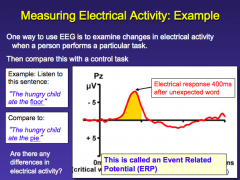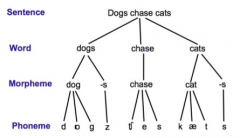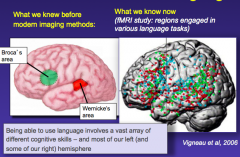![]()
![]()
![]()
Use LEFT and RIGHT arrow keys to navigate between flashcards;
Use UP and DOWN arrow keys to flip the card;
H to show hint;
A reads text to speech;
16 Cards in this Set
- Front
- Back
|
The Lesion Method |
Examining the effect of brain damage or interference on specific cognitive functions |
|
|
Prosopagnosia |
Selective inability to recognise faces |
|
|
Double Dissociations in Memory |

Show there are 2 different brain structures for Long and Short Term Memory |
|
|
Studies of Amnesia |

Amnesics often remember early memories still, as they become consolidated over time as they are frequently recalled. |
|
|
Disadvantages of Lesion Method (COLD) |
1. Can't compare someone to their previous condition 2. Human brain damage is a chance occurrence 4. Can't dictate which demographic you want to study |
|
|
Lesion Method Technologies; Transcranial Magnetic Stimulation |
- A high-powered magnet delivers a magnetic pulse to the brain and temporarily interferes with cognitive function in that region |
|
|
Neuroimaging Techniques |
Use measures of brain activity as 'markers' of different cognitive processes. 2 Types; |
|
|
Electroencephalography (EEG) |

Electrode cap placed on scalp to measure activity at rest and during tasks. Can then compare these to get an ERP |
|
|
Event Related Potential (ERP) |
Electrical changes in the brain that correspond to to the brain's response to a specific event - measured with EEG |
|
|
Advantages & Disadvantages of EEG |
+ Great temporal resolution - can detect changes occurring just 50ms after the stimulus event + Can tell which hemisphere of the brain is responding faster |
|
|
PET & fMRI Scans |
- PET maps uptake of a radioactively tagged substance (usually oxygen) - Subtraction design used to compare a scan from a similar task except for the element you're interested in |
|
|
Advantages & Disadvantages of Measuring Blood Changes |
+ Good spatial resolution |
|
|
Linguistics vs. Psycholinguistics |
Linguistics - language as a system of communication eg. rules for combining words into sentences |
|
|
Language is... |
- Arbitrary |
|
|
Structure of Language |

Phoneme - basic units of sound, abstract and language-specific |
|
|
Broca's Aphasia vs. Wernickes Aphasia |

Patient JG with Broca's omitted function words, |

